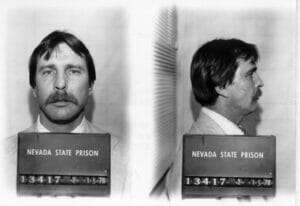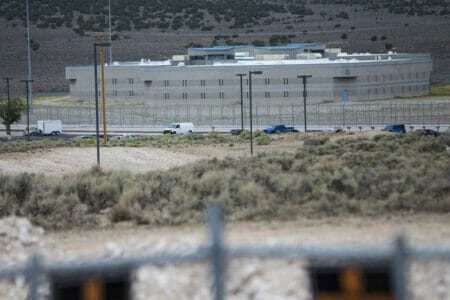Carroll Cole was a serial killer who would be executed by the State of Nevada for a series of murders however it is his earliest murder that most people remember. When Carroll Cole was just eight years old he would drown another eight year old while the two were swimming. The death would be ruled to be accidental however when Carroll Cole was writing his biography in prison he would confess to this murder.
Carroll Cole would be in and out of mental hospitals throughout his teens and for some reason they would let him out even though many of the staff were against it. Carroll Cole would soon get married to a prostitute and then burn down a motel as he believed his wife was having sex with other men there. Carroll Cole would be convicted of arson and sent to prison
Once out of prison Carroll Cole would be arrested again after attempting to strangle an eleven year old girl. Again Carroll Cole was sent to prison and this time for five years
Once free from prison Carroll Cole attempted to strangle two women however this time he ended up in another mental hospital. Again the staff would free Carroll after a few years. Carroll Cole would head to California
The first woman was killed in San Diego in 1971 and would murder another woman only a few weeks later. Carroll tried to explain the killings by saying the women were having affairs on their husbands so deserved to die as it reminded him of his mothers actions
Carroll Cole would get married yet again in 1973 and the marriage was as strained as his first one. Carroll Cole would frequently leave the home where he would murder more women.
Carroll would go to Las Vegas where he would murder yet another woman before fleeing the State and heading to Texas. While in Texas Cole would murder three more women by strangulation however he was caught at the murder scene during the third murder.
Carroll Cole would end up confessing to fifteen murders and would be sentenced to life without parole in Texas however the murder in Las Vegas would come back to haunt him as he was convicted in Nevada and sentenced to death. Carroll Cole would be executed by lethal injection in 1985.
Carroll Cole More News
Convicted killer Carroll Edward Cole, who insisted that prolonging his life would be a waste of tax dollars, died by lethal injection here early Friday, the first execution in the Far West since 1979.
Cole, convicted of killing five women, fulfilled his death wish shortly after 2 a.m., when officials at Nevada’s maximum-security prison sent powerful doses of three undisclosed drugs flowing though an intravenous needle in the condemned man’s arm.
Strapped to a padded table in a converted gas chamber, Cole, 47, blinked repeatedly but showed no emotion waiting for the lethal drugs to course through his veins. He had been sedated earlier to prevent any final resistance.
Seventeen reporters and eight designated witnesses–nearly all of them court or law enforcement officials–had gathered to watch the execution. But looking out from behind one of the chamber’s three large windows, Cole seemed to notice only two of the witnesses, Mike and Judy Newton, a Las Vegas couple writing his biography.
His last words were to them: “It’s all right,” he mouthed through the glass.
Took Five Minutes
Moments later, as the lethal drugs began to flow, Cole closed his eyes, coughed and appeared to convulse, gasping for breath. Over the next several seconds, his chest heaved mechanically and his head slowly arched back. His lips parted; his eyelids opened slightly.
Then, he lay still. It had taken Cole five minutes to die.
“He was ready to go; he wanted to go,” said his attorney, Edward G. (Ted) Marshall, one of the official witnesses.
The last execution west of Texas occurred Oct. 22, 1979, on the very spot where Cole died. On that day, Jesse Walter Bishop of Garden Grove, Calif., went to the gas chamber for gunning down a honeymooner in a Las Vegas casino robbery.
Cole’s execution–the 50th since the U.S. Supreme Court restored the death penalty in 1976–marked the first time that execution by lethal injection was used in this state, where the gas chamber was born in 1924.
Nevada lawmakers authorized the use of lethal injections last year after George W. Sumner, director of state prisons, complained that the old chamber had leaks. Supporters of the switch declared it a more humane means of executing Cole and the other 28 men and two women on Nevada’s Death Row.
A one-time San Diego resident who was raised in Richmond, Calif., the stubby, tattooed Cole was convicted in Texas of strangling three Dallas women in 1980. He was sentenced to life in prison.
Confessed to 13 Murders
In February, 1984, Cole was extradited to Nevada, where seven months later he received the death sentence for strangling two Las Vegas women in 1977 and 1979.
Cole confessed to 13 murders and once told a psychiatrist that he killed 35 people, all but one of them women whom he usually picked up in bars.
To the end, Cole rejected all legal efforts to save him.
“I just messed up my life so bad that I just don’t care to go on,” he told one interviewer last week.
Given Cole’s insistence that he be put to death, not even the American Civil Liberties Union attempted to intervene in his behalf.
But there was one last-minute effort to save his life.
On Thursday night, Nevada’s five Supreme Court justices met briefly to review a petition filed earlier in the day by three Death Row inmates anxious to delay Cole’s date with death.
Fearing that his willingness could hasten their own scheduled executions, the inmates contended that Cole was mentally unbalanced and entitled to better psychiatric evaluation than was available at the prison.
The high court disagreed, deliberating about half an hour before denying a stay of execution.
Cole spent his last day under constant watch in a special, third-story cell less than 20 paces from the death chamber.
He wore new prison denims and his old white sneakers. The laces of the shoes had been removed to prevent any possibility of his hanging himself.
Dines on Shrimp and Chowder
At 5:30 p.m., Cole was served his last meal. He was given what he had requested: tossed salad with French dressing, jumbo shrimp, French fries and Boston clam chowder. He also finished off what remained of the 25 pounds of cookies and candy sent him last week by the Newtons.
Then Cole, a Catholic, wiled away his final hours playing cards with the prison priest.
At 12:20 a.m., he received the first of two shots of Valium intended to calm him. He hardly seemed to need it.
“He wasn’t nervous at all,” said Harol L. Whitley, the prison warden.
Outside, on the parking lot of the sober, gray granite prison, about a dozen people gathered under a crescent moon to light candles in protest of Cole’s execution.
“It’s a time to witness against the whole concept of vengeance,” said a spokesman for the group, Reno community organizer Bob Fulkerson.
At 1:43 a.m., wearing leg irons and a chain attached to his waist and wrists, Cole was escorted into the death chamber and lifted onto the table by four corrections officers who had volunteered for the job. When the medical equipment was in place 23 minutes later, the execution began.
Positioned behind a wall so that he could not be identified, a volunteer from the prison staff inserted a syringe filled with lethal liquid into the intravenous needle.
In all, Cole was injected with three drugs to stop his heart and disrupt his breathing.
There was no noise, except for the whirring of a nearby wall fan. The witnesses–one or two of them dabbing moist eyes–watched quietly as Cole convulsed.
Cole was declared dead at 2:10 a.m.
Family Didn’t Attend
His body was taken to a Carson City mortuary, where a prominent Las Vegas neurologist planned to examine Cole’s brain for any biological evidence that might explain his life of violence.
Cole is survived by a brother and three sisters. None attended his execution, and his body was not claimed.
After an autopsy, his remains were to be cremated.
The cell blocks, steaming in the cold night air, were silent as Cole’s body was wheeled to a waiting station wagon for the three-mile ride to the mortuary.
The temperature by 2:35 a.m. had dipped to 26 degrees as the vehicle made its way past the prison gate.
The death penalty protesters keeping vigil on the parking lot had already gone home.
https://www.latimes.com/archives/la-xpm-1985-12-07-mn-14259-story.html





